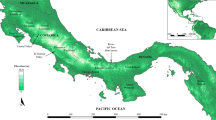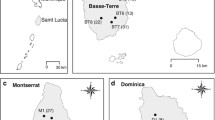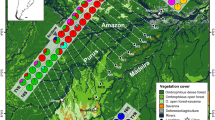Abstract
Many tropical organisms show large genetic differences among populations, yet the prevalent drivers of the underlying divergence processes are incompletely understood. We explored the effect of several habitat and natural history features (body size, macrohabitat, microhabitat, reproduction site, climatic heterogeneity, and topography) on population genetic divergence in tropical amphibians, based on a data set of 2680 DNA sequences of the mitochondrial cytochrome b gene in 39 widely distributed frog species from Brazil, Central America, Cuba, and Madagascar. Generalized linear models were implemented in an information-theoretic framework to evaluate the effects of the six predictors on genetic divergence among populations, measured as spatially corrected pairwise distances. Results indicate that topographic complexity and macrohabitat preferences have a strong effect on population divergence with species specialized to forest habitat and/or from topographically complex regions showing higher phylogeographic structure. This relationship changed after accounting for phylogenetic relatedness among taxa rendering macrohabitat preferences as the most important feature shaping genetic divergence. The remaining predictors showed negligible effects on the observed genetic divergence. A similar analysis performed using the population-scaled mutation rate (Θ) as response variable showed little effect of the predictors. Our results demonstrate greater evolutionary independence among populations of anurans from forested regions versus species from open habitats. This pattern may result from lower vagility and stringency in reproductive requirements of rainforest species. Conversely, open landscapes may offer ephemeral and unstable breeding sites suitable for vagile generalist species, resulting in reduced intraspecific divergence. Our results predict that, for a given period of time, there should be a higher chance of speciation in tropical anurans living in forests than in species adapted to open habitats.


Similar content being viewed by others
References
Aguinagalde I, Hampe A, Mohanty A, Martín JP, Duminil J, Petit RJ (2005) Effects of life-history traits and species distribution on genetic structure at maternally inherited markers in European trees and shrubs. J Biogeogr 32:329–339
Alvarez N, Thiel-Egenter C, Tribsch A, Holderegger R, Manel S, Schönswetter P, Taberlet P, Brodbeck S, Gaudeul M, Gielly L, Küpfer P, Mansion G, Negrini R, Paun O, Pellecchia M, Rioux D, Schüpfer F, Loo MV, Winkler M, Gugerli F, Consortium I (2009) History or ecology? Substrate type as a major driver of spatial genetic structure in Alpine plants. Ecol Lett 12:632–640
Arbogast BS, Kenagy GJ (2001) Comparative phylogeography as an integrative approach to historical biogeography. J Biogeogr 28:819–825
Avise JC (2000) Phylogeography: the history and formation of species. Harvard University Press, Cambridge
Avise JC (2009) Phylogeography: retrospect and prospect. J Biogeogr 36:3–15
Avise JC, Arnoldt J, Ball RM, Bermingham E, Lamb T, Neigel JE, Reeb CA, Saunders NC (1987) Intraspecific phylogeography: the mitochondrial DNA bridge between population genetics and systematics. Annu Rev Ecol Syst 18:489–522
Babik W, Branicki W, Sandera M, Litvinchuk SN, Borkin LJ, Irwin JT, Rafiński J (2004) Mitochondrial phylogeography of the moor frog, Rana arvalis. Mol Ecol 13:1469–1480
Bazin E, Glémin S, Galtier N (2006) Population size does not influence mitochondrial genetic diversity in animals. Science 312:570–572
Blomberg SP, Garland T, Ives AR (2003) Testing for phylogenetic signal in comparative data: behavioral traits are more labile. Evolution 57:717–745
Blonde B, Lamanna C, Violle C, Enquist BJ (2014) The n-dimensional hypervolume. Global Ecol Biogeogr 23:595–609
Bossuyt F, Milinkovitch MC (2000) Convergent adaptive radiations in Madagascan and Asian ranid frogs reveal covariation between larval and adult traits. Proc Natl Acad Sci USA 97:6585–6590
Brown JL, Yoder AD (2015) Shifting ranges and conservation challenges for lemurs in the face of climate change. Ecol Evol 5:1131–1142
Bruford MW, Hanotte O, Brookfield JFY, Burke T (1992) Single-locus and multilocus DNA fingerprinting. In: Hoelzel AR (ed) Molecular genetic analysis of populations: a practical approach. IRL Press, Oxford, pp 225–270
Burnham KP, Anderson DR (2002) Model selection and multimodel inference: a practical information-theoretic approach, 2nd edn. Springer, New York
Burnham KP, Anderson DR, Huyvaert KP (2011) AIC model selection and multimodel inference in behavioral ecology: some background, observations, and comparisons. Behav Ecol Sociobiol 65:23–35
Burns EL, Eldridge MDB, Crayn DM, Houlden BA (2007) Low phylogeographic structure in a widespread endangered Australian frog Litoria aurea (Anura: Hylidae). Conserv Genet 8:17–32
Calcagno V, de Mazancourt C (2010) glmulti: an R package for easy automated model selection with (generalized) linear models. J Stat Softw 34:1–29
Carnaval AC (2002) Phylogeography of four frog species in forest fragments of northeastern Brazil—a preliminary study. Integr Comp Biol 42:913–921
Carnaval AC, Moritz C (2008) Historical climate modelling predicts patterns of current biodiversity in the Brazilian atlantic forest. J Biogeogr 35:1187–1201
Carnaval AC, Hickerson MJ, Haddad CFB, Rodrigues MT, Moritz C (2009) Stability predicts genetic diversity in the Brazilian Atlantic Forest hotspot. Science 323:785–789
Chan LM, Zamudio KR (2009) Population differentiation of temperate amphibians in unpredictable environments. Mol Ecol 18:3185–3200
Coyne JA, Orr HA (2004) Speciation. Sinauer Associates, Sunderland
Crottini A, Andreone F, Kosuch J, Borkin LJ, Litvinchuk SN, Eggert C, Veith M (2007) Fossorial but widespread: the phylogeography of the common spadefoot toad (Pelobates fuscus). Mol Ecol 16:2374–2754
Currat M, Ruedi M, Petit RJ, Excoffier L (2008) The hidden side of invasions: massive introgression by local genes. Evolution 62:1908–1920
de Queiroz K (2007) Species concepts and species delimitation. Sys Biol 56:879–886
Dubois A (2004) Developmental pathway, speciation and supraspecific taxonomy in amphibians 1. Why are there so many frog species in Sir Lanka? Alytes 22:19–37
Duminil J, Fineschi S, Hampe A, Jordano P, Salvini D, Vendramin GG, Petit RJ (2007) Can population genetic structure be predicted from life-history traits? Am Nat 169:662–672
Endler JA (1992) Genetic heterogeneity and ecology. In: Berry RJ, Crawford TJ, Hewitt GM (eds) Genes in ecology. Blackwell Science, Oxford, pp 315–334
Fleming K, Johnston P, Zwartz D, Yokoyama Y, Lambeck K, Chappell J (1998) Refining the eustatic sea-level curve since the Last Glacial Maximum using far- and intermediate-field sites. Earth Planet Sci Lett 163:327–342
Fouquet A, Noonan BP, Rodriguez MT, Pech N, Gilles A, Gemmell NJ (2012) Multiple quaternary refugia in the eastern Guiana Shield revealed by comparative phylogeography of 12 frog species. Sys Biol 61:461–489
Frankham R (1997) Do island populations have less genetic variation than mainland populations? Heredity 78:311–327
Galarza JA, Carreras-Carbonell J, Macpherson E, Pascual M, Roques S, Turner GF, Rico C (2009) The influence of oceanographic fronts and early-life-history traits on connectivity among littoral fish species. Proc Natl Acad Sci USA 106:1473–1478
Gaston KJ, Blackburn TM (1996) Range size-body size relationships: evidence of scale dependence. Oikos 75:479–485
Gehara M, Summers K, Brown JL (2013a) Population expansion, isolation and selection: novel insights on the evolution of color diversity in the strawberry poison frog. Evol Ecol 27:797–824
Gehara M, Canedo C, Haddad CFB, Vences M (2013b) From widespread to microendemic: molecular and acoustic analyses show that Ischnocnema guentheri (Amphibia: Brachycephalidae) is endemic to Rio de Janeiro, Brazil. Conserv Genet 14:973–982
Gehring P-S, Pabijan M, Randrianirina JE, Glaw F, Vences M (2012) The influence of riverine barriers on phylogeographic patterns of Malagasy reed frogs (Heterixalus). Mol Phylogenet Evol 64:618–632
Gomez-Uchida D, Knight TW, Riuzzante DE (2009) Interaction of landscape and life history attributes on genetic diversity, neutral divergence and gene flow in a pristine community of salmonids. Mol Ecol 18:4854–4869
Grohmann CH, Smith MJ, Riccomini C (2011) Multiscale analysis of topographic surface roughness in the Midland Valley, Scotland. IEEE Trans Geosci Remote Sens 49:1200–1213
Grosberg RK, Cunningham CW (2001) Genetic structure in the sea: from populations to communities. In: Bertness MD, Gaines S, Hay ME (eds) Marine community ecology. Sinauer Associates, Sunderland, pp 61–84
Guarnizo CE, Cannatella DC (2013) Genetic divergence within frog species is greater in topographically more complex regions. J Zool Syst Evol Res 51:333–340
Guarnizo CE, Cannatella DC (2014) Geographic determinants of gene flow in two sister species of tropical Andean frogs. J Hered 105:216–225
Hauswaldt JS, Ludewig A-K, Vences M, Pröhl H (2011) Widespread co-occurrence of divergent mitochondrial haplotype lineages in a Central American species of poison frog (Oophaga pumilio). J Biogeogr 38:711–726
Hedrick PW (2013) Adaptive introgression in animals: examples and comparison to new mutation and standing variation as sources of adaptive variation. Mol Ecol 22:4606–4618
Hickerson MJ, Carstens BC, Cavender-Bares J, Crandall KA, Graham CH, Johnson JB, Rissler LJ, Victoriano PF, Yoder AD (2010) Phylogeography’s past, present, and future: 10 years after Avise, 2000. Mol Phylogenet Evol 54:291–301
Hijmans RJ, Cameron SE, Parra JL, Jones PG, Jarvis A (2005) Very high resolution interpolated climate surfaces for global land areas. Int J Climatol 25:1965–1978
Irwin DE (2002) Phylogeographic breaks without geographic barriers to gene flow. Evolution 56:2383–2394
Iturralde-Vinent MA (2006) Meso-cenozoic Caribbean paleogeography: implications for the historical biogeography of the region. Int Geol Rev 48:791–827
IUCN (2013) The IUCN red list of threatened species. In: International Union for Conservation of Nature and Natural Resources
Jehle R, Burke T, Arntzen JW (2005) Delineating fine-scale genetic units in amphibians: probing the primacy of ponds. Conserv Genet 6:227–234
Kembel SW, Cowan PD, Helmus MR, Cornwell WK, Morlon H, Ackerly DD, Blomberg SP, Webb CO (2010) Picante: R tools for integrating phylogenies and ecology. Bioinformatics 26:1463–1464
Knutson MG, Richardson WB, Reineke DM, Gray BR, Parmelee JR, Weick SE (2004) Agricultural ponds support amphibian populations. Ecol Appl 14:669–684
Kuchta SR, Tan A-M (2005) Isolation by distance and post-glacial range expansion in the rough-skinned newt, Taricha granulosa. Mol Ecol 14:225–244
Liu K, Wang F, Chen W, Tu L, Min M-S, Bi K, Fu J (2010) Rampant historical mitochondrial genome introgression between two species of green pond frogs, Pelophylax nigromaculatus and P. plancyi. BMC Evol Biol 10:201
Luiz OJ, Madin JS, Robertson DR, Rocha LA, Wirtz P, Floeter SR (2012) Ecological traits influencing range expansion across large oceanic dispersal barriers: insights from tropical Atlantic reef fishes. Proc R Soc B 279:1033–1040
Makowsky R, Chesser J, Rissler LJ (2009) A striking lack of genetic diversity across the wide-ranging amphibian Gastrophryne carolinensis (Anura, Microhylidae). Genetica 135:169–183
Measey GJ, Vences M, Drewes RC, Chiari Y, Melo M, Bourles B (2007) Freshwater paths across the ocean: molecular phylogeny of the frog Ptychadena newtoni gives insights into amphibian colonization of oceanic islands. J Biogeogr 34:7–20
Meirmans PG, Hedrick PW (2011) Assessing population structure: Fst and related measures. Mol Ecol Res 11:5–18
Nabholz B, Glémin S, Galtier N (2009) The erratic mitochondrial clock: variations of mutation rate, not population size, affect mtDNA diversity across birds and mammals. BMC Evol Biol 9:54
Nevo E, Beiles A (1991) Genetic diversity and ecological heterogeneity in amphibian evolution. Copeia 1991:565–592
Pabijan M, Wollenberg KC, Vences M (2012) Small body size increases the regional differentiation of populations of tropical mantellid frogs (Anura: Mantellidae). J Evol Biol 25:2310–2324
Papadopoulou A, Anastasiou I, Keskin B, Vogler AP (2009) Comparative phylogeography of tenebrionid beetles in the Aegean archipelago: the effect of dispersal ability and habitat preference. Mol Ecol 18:2503–2517
Papadopoulou A, Anastasiou I, Spagopoulou F, Stalimerou M, Terzopoulou S, Legakis A, Vogler AP (2011) Testing the species–genetic diversity correlation in the Aegean archipelago: toward a haplotype-based macroecology? Am Nat 178:241–255
Paradis E (2010) pegas: an R package for population genetics with an integrated-modular approach. Bioinformatics 26:419–420
Paradis E, Claude J, Strimmer K (2004) APE: analyses of phylogenetics and evolution in R language. Bioinformatics 20:289–290
Peterson MA, Denno RF (1998) The influence of dispersal and diet breadth on patterns of genetic isolation by distance in phytophagous insects. Am Nat 152:428–446
Phillips BL, Brown GP, Webb JK, Shine R (2006) Invasion and the evolution of speed in toads. Nature 439:803
Pyron RA, Wiens JJ (2011) A large-scale phylogeny of Amphibia including over 2,800 species, and a revised classification of extant frogs, salamanders, and caecilians. Mol Phylogenet Evol 61:543–583
Rabemananjara FCE, Chiari Y, Ramilijaona OR, Vences M (2007) Evidence for recent gene flow between north-eastern and south-eastern Madagascan poison frogs from a phylogeography of the Mantella cowani group. Front Zool 4:1
R-Development Core Team (2014) R: A language and environment for statistical computing. Version 3.1.1. R Foundation for Statistical Computing, Vienna, Austria
Richardson JL (2012) Divergent landscape effects on population connectivity in two co-occurring amphibian species. Mol Ecol 21:4437–4451
Riddle BR, Hafner DJ (1999) Species as units of analysis in ecology and biogeography: time to take the blinders off. Global Ecol Biogeogr 8:433–441
Rissler LJ, Smith WH (2010) Mapping amphibian contact zones and phylogeographical break hotspots across the United States. Mol Ecol 19:5404–5416
Robertson JM, Duryea MC, Zamudio KR (2009) Discordant patterns of evolutionary differentiation in two Neotropical treefrogs. Mol Ecol 18:1375–1395
Rocha LA, Rocha CR, Robertson DR, Bowen BW (2008) Comparative phylogeography of Atlantic reef fishes indicates both origin and accumulation of diversity in the Caribbean. BMC Evol Biol 8:e157
Romiguier J, Gayral P, Ballenghien M, Bernard A, Cahais V, Chenuil A, Chiari Y, Dernat R, Duret L, Faivre N, Loire E, Lourenco JM, Nabholz B, Roux C, Tsagkogeorga G, Weber AA, Weinert LA, Belkhir K, Bierne N, Glémin S, Galtier N (2014) Comparative population genomics in animals uncovers the determinants of genetic diversity. Nature 515:261–263
Santos JC (2012) Fast molecular evolution associated with high active metabolic rates in poison frogs. Mol Biol Evol 29:2001–2018
Scheffers BR, Edwards DP, Diesmos A, Williams SE, Evans TA (2014) Microhabitats reduce animal’s exposure to climate extremes. Glob Change Biol 20:495–503
Schliep KP (2011) phangorn: phylogenetic analysis in R. Bioinformatics 27:592–593
Servant M, Maley J, Turcq B, Absy M-L, Brenac P, Fournier M, Ledru M-P (1993) Tropical forest changes during the Late Quaternary in African and South American lowlands. Global Planet Change 7:25–40
Smith SA, Oca ANMd, Reeder TW, Wiens JJ (2007) A phylogenetic perspective on elevational species richness patterns in Middle American treefrogs: why so few species in lowland tropical rainforests? Evolution 61:1188–1207
Swofford DL (2003) PAUP* Phylogenetic analysis using parsimony (*and other methods). Version 4. Sinauer Associates, Sunderland, Massachusetts
Tamura K, Peterson D, Peterson N, Stecher G, Nei M, Kumar S (2011) MEGA5: molecular evolutionary genetics analysis using maximum likelihood, evolutionary distance, and maximum parsimony methods. Mol Biol Evol 28:2731–2739
Thomas MF (2008) Understanding the impacts of Late Quaternary climate change in tropical and sub-tropical regions. Geomorphology 101:146–158
Tilston-Smith B, McCormack JE, Cuervo AM, Hickerson MJ, Aleixo A, Cadena CD, Pérez-Emán J, Burney CW, Xie X, Harvey MG, Faircloth BC, Glenn TC, Derryberry EP, Prejean J, Fields S, Brumfield RT (2014) The drivers of tropical speciation. Nature 515:406–409
Turelli M, Barton NH, Coyne JA (2001) Theory and speciation. Trends Ecol Evol 16:330–343
Van Bocxlaer I, Loader SP, Roelants K, Biju SD, Menegon M, Bossuyt F (2010) Gradual adaptation toward a range-expansion phenotype initiated the global radiation of toads. Science 372:679–682
Vásquez D, Correa C, Pastenes L, Palma RE, Méndez MA (2013) Low phylogeographic structure of Rhinella arunco (Anura: Bufonidae), an endemic amphibian from the Chilean Mediterranean hotspot. Zool Stud 52:35e
Vences M, Wake DB (2007) Speciation, species boundaries and phylogeography of amphibians. In: Heatwole H (ed) Amphibian Biology. Surrey Beatty & Sons, Chipping Norton, pp 2613–2671
Vences M, Aprea G, Capriglione T, Andreone F, Odierna G (2002) Ancient tetraploidy and slow molecular evolution in Scaphiophryne: ecological correlates of speciation mode in Malagasy relict amphibians. Chromosome Res 10:127–136
Vences M, Vieites DR, Glaw F, Brinkmann H, Kosuch J, Veith M, Meyer A (2003) Multiple overseas dispersal in amphibians. Proc R Soc B 270:2435–2442
Vences M, Hauswaldt JS, Steinfartz S, Rupp O, Goesmann A, Künzel S, Orozco-terWengel P, Vieites DR, Nieto-Roman S, Haas S, Laugsch C, Gehara M, Bruchmann S, Pabijan M, Ludewig A-K, Rudert D, Angelini C, Borkin LJ, Crochet P-A, Crottini A, Dubois A, Ficetola GF, Galán P, Geniez P, Hachtel M, Jovanovic O, Litvinchuk SN, Lymberakis P, Ohler A, Smirnov NA (2013) Radically different phylogeographies and patterns of genetic variation in two European brown frogs, genus Rana. Mol Phylogenet Evol 68:657–670
Wells KD (2007) The ecology and behavior of amphibians. The University of Chicago Press, Chicago
Wollenberg KC, Vieites DR, van der Meijden A, Glaw F, Cannatella DC, Vences M (2008) Patterns of endemism and species richness in Malagasy cophyline frogs support a key role of mountainous areas for speciation. Evolution 62:1890–1907
Wollenberg KC, Vieites DR, Glaw F, Vences M (2011) Speciation in little: the role of range and body size in the diversification of Malagasy mantellid frogs. BMC Evol Biol 11:217. doi:10.1186/1471-2148-11-217
Wright S (1943) Isolation by distance. Genetics 28:114–138
Youngquist MB, Boone MD (2014) Movement of amphibians through agricultural landscapes: the role of habitat on edge permeability. Biol Conserv 175:148–155
Zeisset I, Beebe TJC (2008) Amphibian phylogeography: a model for understanding historical aspects of species distributions. Heredity 101:109–119
Zieliński P, Nadachowska-Brzyska K, Wielstra B, Szkotak R, Covaciu-Marcov SD, Cogălniceanu D, Babik W (2013) No evidence for nuclear introgression despite complete mtDNA replacement in the Carpathian newt (Lissotriton montandoni). Mol Ecol 22:1884–1903
Zink RM (2002) Methods in comparative phylogeography, and their application to studying evolution in the North American aridlands. Integr Comp Biol 42:953–959
Acknowledgments
We are grateful to numerous friends and colleagues who have contributed samples and sequences for the present project, or provided assistance during fieldwork. In particular we would like to thank (in alphabetic order) Roberto Alonso, Franco Andreone, Adrian Garda, Sebastian Gehring, Frank Glaw, Jörn Köhler, Roger-Daniel Randrianiaina, Fanomezana Ratsoavina, Leslie Rissler, Axel Strauß, Chris Thawley, and David R. Vieites. Thanks are also due to Meike Kondermann and Gabi Keunecke for help with labwork. We are grateful to authorities in Brazil, Cuba and Madagascar for research, collection, and export permits. This study was carried with funds of the Deutsche Forschungsgemeinschaft (Grant VE247/7-1 to MV). AR and MP were supported by postdoctoral fellowships of the Humboldt Foundation. MG was supported by the Katholischer Akademischer Austauschdienst. CFBH was supported by Grants #2008/50928-1 and #2013/50741-7, São Paulo Research Foundation (FAPESP), and Grant #302518/2013-4, Conselho Nacional de Desenvolvimento Científico e Tecnológico (CNPq).
Author information
Authors and Affiliations
Corresponding author
Electronic supplementary material
Below is the link to the electronic supplementary material.
Rights and permissions
About this article
Cite this article
Rodríguez, A., Börner, M., Pabijan, M. et al. Genetic divergence in tropical anurans: deeper phylogeographic structure in forest specialists and in topographically complex regions. Evol Ecol 29, 765–785 (2015). https://doi.org/10.1007/s10682-015-9774-7
Received:
Accepted:
Published:
Issue Date:
DOI: https://doi.org/10.1007/s10682-015-9774-7




